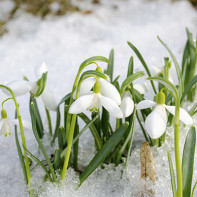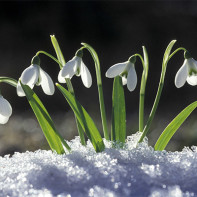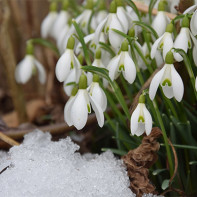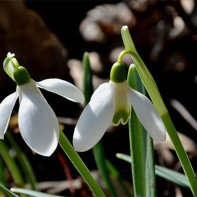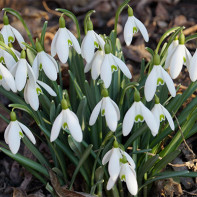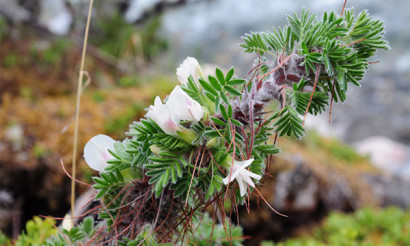Snowdrop: medicinal properties and contraindications
According to a beautiful legend, God drove Adam and Eve out of paradise in winter. Eve endured the cold and snow heavily, and, watching her sufferings, nature decided to encourage the girl and turned some of the tender snowflakes into equally delicate elegant flowers. Since then, at the end of winter or the earliest spring, the land is covered with pleasantly smelling thin exquisite snowdrops.
- Chemical composition
- How it looks and where it grows
- Kinds
- Collection and storage
- The healing properties of snowdrop
- Snowdrop in folk medicine
- From boils and scabies
- From joint pain
- To improve the adrenal glands
- For the treatment of fungus
- Joint pain
- From cystitis and pyelonephritis
- Joint Pain Ointment
- For the treatment of skin problems
- From acute joint pain
- Toothache
- From a lumbago
- Types of healing compounds
- Infusion
- Tincture
- Decoction
- Contraindications
Snowdrop is a typical primrose. It blooms during snowmelt, and since this period occurs in different regions for different periods, it can delight with elegant miniature inflorescences from the last week of February to mid-April, depending on the climatic zone in which it grows.
The scientific name of the snowdrop is galanthus, it has developed from two Greek roots - gal and anthos, which means “milk flower”.
Chemical composition
You need to be on the lookout for this beautiful delicate flower: the whole point is that each part contains a whole group of alkaloids, consisting of 37 substances - nivalin, lycorin, galantin, tazettin, as well as the most popular galantamine. Its greatest concentration is concentrated in the bulb. Galantamine has the ability to affect the central nervous system, stimulating the activity of brain and spinal cord cells, for which this plant is used in official medicine.
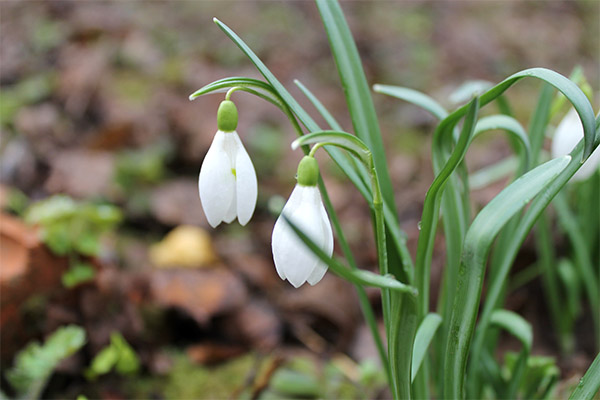
Nivalin has also long been used for medicinal purposes. In particular, Tibetan monks with his help removed spasms of the vessels of the legs and treated for oncology, which, however, did not find application in official medicine.
If we consider the overall distribution of alkaloids in the plant, it should be noted that tazettin predominates in the bulbs and licorin in the leaves.
The next component of snowdrop is tannins. Their distinctive feature is the ability to neutralize carcinogens, free the intestines from toxins and protect the gastrointestinal tract from inflammation, stop the blood.
Organic acids, which are also an ingredient in this medicinal plant, support the immune system and the acid-base balance of the human body, improve intestinal function and stimulate the synthesis of gastric juice.
Mineral compounds, sugars, lipids and vitamins are also found in various parts of the snowdrop, but their properties are not used in practice.
How it looks and where it grows
Snowdrop botany belongs to perennial bulbous plants. The growing season is short - only a few weeks. First, it delights with delicate flowers, after two weeks they die off, and after them the leaves fade in speed.
The snowdrop bulb has a small one - from 2 to 3 cm. It is formed from last year and the year before last scales, it also has a kidney of renewal. Scales form every year - three per season. In their sinuses children are hiding the bulbs.
Every spring from the bulbs in a friendly bunch appear long linear leaves. At the same time, buds are shown. Their flower stalks grow above the leaves, which seem to fade into the background, giving the world the first beautiful flowers to admire. True, after flowering, the leaves begin active growth and can reach 20 cm in length with a width of up to 3 cm. The tops of leaves in different types of snowdrop are either pointed or rounded.
The color of the leaves can be either light green, even with some yellowish tint, or densely green.Leaf blades look dull and shiny, as if covered with a coating of grease or wax. For some types of plants, a smooth leaf is characteristic, for others - in a fold.
The pedicel has the shape of a tube; it is usually shiny. The bract consists of three outer leaflets-petals of white color, quite long - up to 3 cm, and three inner ones.
Stamens sit deep inside the flower. The plant is pollinated by the first early insects - bees, flies, butterflies. And already in May the fruit ripens - this is a rather fleshy juicy box, inside of which, behind the wings, round seeds hide.
Snowdrop grows throughout Europe, with the exception of the harsh northern regions, as well as in the regions of Asia Minor. Especially many plant species are found in the Caucasus. It is the Caucasian foothills that are considered the birthplace of a snowdrop, from where it settled in other territories.
Kinds
Snowdrop has 19 varieties, with more than half of them - 12 - growing in Russia and neighboring countries.
The snowdrop of Voronov got its name from the name of the great specialist in plants of the Caucasus, botanist Yu. N. Voronov. It is this kind of plant that is cultivated and used for medical purposes. It has bright green shiny leaves with a slightly yellowish tint. The leaves are slightly “folded” in half lengthwise, so on the underside there is a so-called keel. At the end of flowering, the leaves grow to 22 cm, deviate from the middle where the peduncle is located, and twist towards the slope.
The flower stalk grows up to 15 cm tall, on it is a flower about 4.5 cm long. The flowering period of Voronov's snowdrop is February or early March. The fruits ripen in May, and already in June the plant dies.
This kind of snowdrop is found only in the Caucasus. Its range runs along the eastern coast of the Black Sea and slightly captures Turkey. It does not go far from the border between water and land, but closer to the southern regions it can rise to the mountains, located about 40 km from the coast. Its element is broad-leaved moist forests.
Snowdrop snow is characterized by gray leaves, as if covered with a coating of wax, at the end of flowering they are stretched to 25 cm. At the end of the white petals there is a green spot in the shape of a horseshoe.
Since its distribution range is quite wide - from the countries of Central and Eastern Europe to Transcaucasia, the flowering time is extended as it moves from the south to the more northern regions - from January to April.
In natural conditions, he is admired by the inhabitants of many European countries - from Germany, which is the northernmost state where snowdrops grow, to Italy, including Sicily. The southernmost latitudes, where this plant is not uncommon, are Turkey. On the territory of Russia, it is easy to meet in the regions of the southern reaches of the Don.
Snow-white can be seen both on the forest edges or in the thickets of shrubs, and in free open spaces - from the foothills to the alpine mountain belt. This plant is the earliest honey plant in nature, from which bees remove nectar even in February.
The narrow-leaved snowdrop is very similar to its relative - snow-white snowdrop, but more miniature. It is found only in Kabardino-Balkaria - it grows among shrubs along the northern slopes of the mountains at a fairly decent height - up to 700 m above sea level. Due to its massive collection for bouquets, the plant is under threat of extinction and is therefore listed in the Red Book of Russia.
Elvis Snowdrop is named after the English botanist Henry John Elvis. It was he who in 1874 was the first to find and describe this kind of plant. Its leaves can be either green or gray, on their tops there is a small hood. The flowers are medium-sized, with petals up to 2 cm long; on their base and apex there is a green spot. Distributed in Bulgaria, in the eastern territories of the previously existing Yugoslavia, in all but the eastern regions of Turkey and on the islands in the Aegean Sea. Widely used in garden decorative floriculture.
Flat-snowed snowdrops can be found only on mountain meadows and slopes of the gorges of North Ossetia and Georgia, it does not grow anywhere else in the world. Its bulb is one of the largest among all types of snowdrops - up to 5 cm in length and about 4 cm in diameter, white flakes. Shiny leaves of a deep dark green color, flat and wide, with a distinctive petiole. After flowering, they grow up to 25 cm, have a width of over 3.5 cm. After flowering, the flower stalk continues to grow and extends up to 22 cm, while it usually does not exceed 15 cm. The flowering period of the snowdrop is april and may.
The folded snowdrop is characterized by cartilaginous folded blunt bluish-green leaves. They seem to be covered with a waxy coating, and after flowering they become greasy. The flower stalk is also covered with wax, the flowers are large, with petals up to 5 cm. At first they are much longer than the peduncle, but it continues to grow during the flowering period and eventually gains the desired length.
Snowdrop blooms in March and April and has a deep and bright smell. Its distribution area is mountains and foothills of Moldova, Crimea and Romania, where it grows on forest edges and in thickets of bushes. This species of plant was so fond of flower growers that they developed on its basis 10 varieties of decorative snowdrops that perfectly took root in Russian gardens.
Queen Olga’s snowdrop has a very small oval bulb - no more than 2 cm in length and 1.5 cm in diameter. This type of snowdrop is distinguished by the fact that its leaves are not exposed to the light of day in spring, but in autumn, far after flowering, in September and October. The flowers are medium, with petals up to 2.5 cm in length. This snowdrop grows on the fringes of forests of fir and spruce in southern Greece.
Collection and storage
The most valuable from a medicinal point of view is the snowdrop bulb; its collection is carried out in April or May. But since the snowdrop is recognized as a disappearing plant, and many of its varieties are listed in the federal and regional Red Books, it is better to collect aerial parts - flowers and leaves. They also have many healing properties.
It is important not to make a mistake and take the plant only if you are completely sure that it is a snowdrop. The surest thing is to go to workpieces to places where the snowdrop grows massively, quite densely and densely.
Before going for a medicinal plant, you need to get gloves in which to collect raw materials so as not to get poisoned by the potent substances that make up the bulbs, leaves and flowers.
Weather for blanks to choose sunny, warm and clear. It is better to start work before dinner, when the dew has already come down.
The specific date of collection of medicinal raw materials must be determined by the stage at which the flower blooms. It is best not to delay and start collecting when the buds have just opened. In no case do you have to wait until the flowering is nearing the end and seed boxes begin to be tied.
It is not necessary to collect all the plants in a row - in this case, the snowdrop population in this place will never recover. After digging the bulbs thoroughly shake off the soil, cut off the roots with a secateurs, rinse the raw materials and use fresh ones. Bulbs can make juice or water and alcohol tinctures.
The green part of the plants should also be cut off during flowering, spread out on paper or cotton cloth on a well-ventilated veranda or just under a canopy so that rain does not fall. After drying, grind into a powder, on the basis of which then prepare decoctions and water tinctures. Store in well-corked glassware for a year.
Before preparing medicinal compounds from medicinal raw materials, you need to make sure that the grass has not deteriorated. Opening the dishes where the powder is stored, you need to smell it. There should be no extraneous odors - only the aroma of the plant. You should also pay attention to the appearance and color and use only the raw materials that have been preserved impeccably.
The healing properties of snowdrop
In the snowdrop, the alkaloid galantamine is of the greatest medical interest.It is the main component of the plant on which the treatment methods are based.
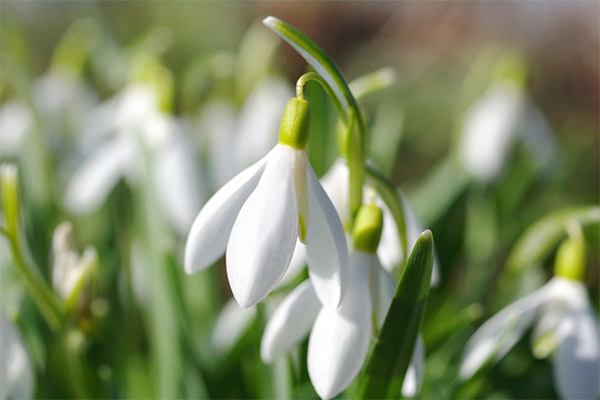
- Galantamine is considered a non-alternative treatment for the symptoms of poliomyelitis and cerebral palsy. The alkaloid's effectiveness has been recognized for relieving suffering from radiculitis, polyneuritis, myopathy, as well as for recovering from serious injuries affecting the motor nerves, especially in the process of recovery from traffic accidents. Its use is due to the ability of galantamine to restore connections between the nervous and muscle systems, which plays an important role in improving the mobility of arms and legs. Moreover, the effectiveness of snowdrops has been confirmed many times by practice during the outbreak of poliomyelitis that occurred after the Great Patriotic War, when other means of combating this formidable disease were simply not available.
- Compositions based on snowdrop, and prepared from any of its parts - from the bulb to the flowers, help reduce the frequency of epileptic seizures, relieve cramps, calm nerves, smooth out the hysterical state, relieve insomnia and establish a healthy, good sleep.
- Due to the ability of galantamine to lower blood pressure, it is used to treat the initial degrees of hypertension. Heart disease is another area of application for a medicinal plant.
- Galantamine improves intestinal motility and stimulates the formation of saliva, so it can be used to establish digestion. In gynecology, the snowdrop alkaloid is also in demand: it helps to relieve inflammation of the organs of the female genital area, and also eliminates the problems of the menstrual cycle, especially if they were associated with scanty and painful menstruation.
- Snowdrop shows good results as a means of combating skin problems - such as a fungal infection or scabies, since this medicinal plant has antimycotic abilities.
- Compounds based on it also do well with boils and abscesses, and their antiseptic effect, characteristic of the galantamine alkaloid, is the basis of their action. To eliminate these problems, decoctions and tinctures from snowdrop are used externally. Due to the antiseptic effect, they are also used internally - they are used as an additional tool in the treatment of colds and bronchitis. With angina, you can gargle with drugs from this plant.
Snowdrop in folk medicine
Most often, traditional healers prescribe snowdrop compositions externally, and usually they are alcohol or water tinctures on the bulbs or green parts of the plant. But there is in their healing arsenals and means for internal use.
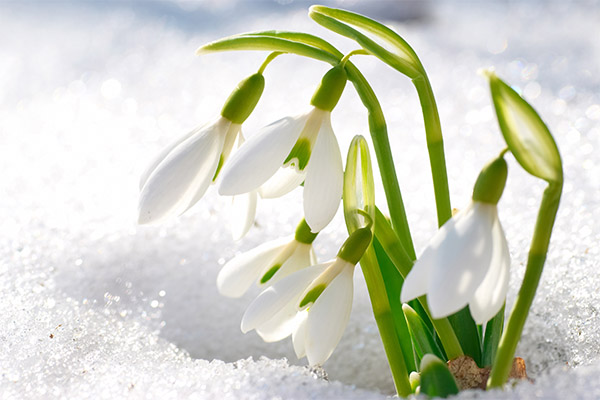
It is important not to forget, after topical application of medicinal compounds based on snowdrops, rinse with water the places of application of the product and hands so that there are no unpleasant symptoms of poisoning.
From boils and scabies
To prepare this tincture, snowdrop bulbs will be required. For 10 g of bulbs, take 1 l of undiluted medical alcohol. Chop the onions lightly with a knife (this must be done with gloves so as not to get poisoning) and pour alcohol in a clean glass dish - for example, in a jar. The jar is tightly closed and removed for a month to insist in a dark, cool room. When the tincture is ready, strain and store it, be sure to make an indication on the bank that it is a poisonous remedy.
Such a composition is used to treat the skin with fungal infections, as well as in case of its defeat by boils or scabies.
From joint pain
To prepare tinctures that relieve pain in large and small joints, with radiculitis, you can take 50 g of bulbs or 100 g of leaves.Grind and pour medicinal raw materials with pure medical alcohol (one liter). Remove for a month in a dark, cold place to insist. Then filter and use as compresses. In order not to burn the skin, apply a compress for no more than 15 minutes. You can simply wipe tincture of sore spots.
To improve the adrenal glands
In order to normalize the activity of the adrenal glands, tincture on flowers is used. They need to be collected a lot - about 80 g of flowers along with peduncles. Pour fresh raw materials in a glass or ceramic bowl with half a liter of quality vodka. Insist in a place where sunlight will not fall on the tank for 40 days. Then strain the tincture and consume 3 times a day before meals. The intake rate at a time is no more than 20 drops. To improve palatability, you can combine the reception with half a teaspoon of honey.
For the treatment of fungus
For a long time, witches have been using an aqueous cold extract of snowdrop to combat fungal skin diseases. To prepare it, freshly picked leaves of the plant (three small bunches) must be poured with 3 liters of cold water and left for 12 hours. After this time, the composition for the foot bath is ready. It is better to cook it in the morning, to apply it every evening - until the symptoms of the fungal infection disappear. The duration of the procedure is up to 20-30 minutes. Before lowering the feet into the healing product, it must be heated to a comfortable temperature.
Joint pain
A decoction of the leaves and flowers of the plant is effective for pain in the joints - both large and small. To prepare it, the aboveground parts of the plant are needed - leaves and flowers. Boil a good bunch of plants for a quarter of an hour in half a liter of water. When it cools down to a warm state, strain, moisten gauze or a cotton cloth in the healing composition and apply in the form of a compress to problem areas. Do not hold such a compress for more than 15 minutes - a burn may appear. It is better to carry out the procedure before bedtime, then immediately wrap the affected joint with a warm shawl or scarf for the whole night.
From cystitis and pyelonephritis
Snowdrop is used by traditional healers to treat inflammation of the organs of the excretory system - the kidneys and bladder - such as cystitis or pyelonephritis. This composition will also help to get rid of enuresis or frequent and uncontrolled urination. To prepare it, you need a powder from the dried leaves and flowers of the plant. Pour 300 ml of boiling water into 10 g of healing powder and send the composition to a water bath, where it is warmed up for 20 minutes. Remove, cool and strain. Drink 5 g (or a teaspoon) 3 times a day. Along with taking this remedy, you need to drink plenty of fluids. The result will be a successful elimination of the infection from the kidneys and bladder.
Joint Pain Ointment
Observing all precautions, grind a glass of medicinal plant bulbs on a grater or using a blender. Mix the resulting slurry with goat fat (5 cups) in a heat-resistant bowl. Cover and send for 3 hours to the oven, where the mixture is languished at a temperature of about 150 degrees. When the ointment has cooled, it can be used not only to alleviate suffering from joint pain, but also to treat skin problems - scabies, fungal infections, boils. You need to apply it daily - before you go to bed at night. The number of procedures depends on the duration of the disease, continue grinding until its symptoms disappear.
For the treatment of skin problems
Pick up snowdrop flowers (one glass), skip them in a meat grinder. Spread the resulting slurry evenly over the cotton fabric and apply as a compress to the sore joint or surface of the skin damaged by the fungus. Cover with plastic wrap on top, the duration of the procedure is 15 minutes.
From acute joint pain
Break a handful of snowdrop flowers (with pedicels) using a blender. Put the slurry in the form of an application on the joint that does not rest. After 15 minutes, rinse the healing product with clean water. Snowdrop will relieve pain, reduce inflammation.
Toothache
If the tooth hurts or the cheek swells after the dentist has removed the tooth, rinsing the oral cavity with the diluted tincture of snowdrop will help. Such a tool must be prepared in a special way. Pour vodka (0.5 L) with 80 flowers of a medicinal plant. Put the bottle with the mixture on the sunny windowsill for 40 days. Shake the tincture daily. When it is ready, filter the liquid and put it into storage - now in a dark, cool room. To rinse your mouth, dilute a teaspoon of the product in boiled water. A gauze swab dipped in tincture can be put on a bad tooth for 15 minutes.
To enhance the therapeutic effect, supplement the procedure by taking the drug inside: 3 times a day, before eating, drink 20 drops. Drink with water and honey dissolved in it (half a teaspoon per 100 ml of liquid).
From a lumbago
This remedy treats not only sciatica and arthritis, but also intestinal atony. You need to take 20 g of dry powder from a medicinal plant, pour 0.5 l of boiled water into it and let stand in a water bath for 15 minutes. Cool, filter and take a teaspoon 2-3 times a day. The duration of treatment is determined by the neglect and severity of the disease. Stop taking the drug after a complete cure. The same composition is also suitable for alleviating the condition in poliomyelitis, cerebral palsy and oncological diseases - but only as an adjunct, in addition to the pharmaceutical preparations prescribed by the attending physician.
Types of healing compounds
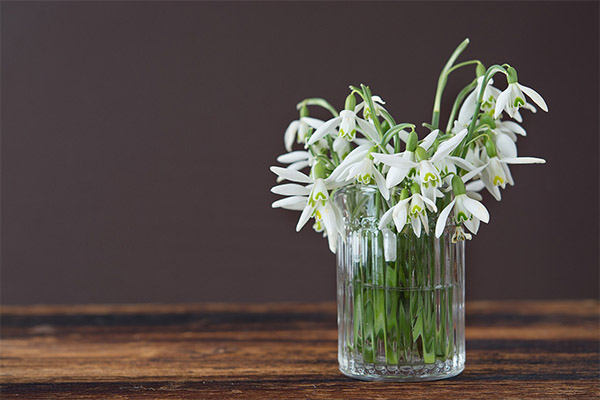
Infusion
Cold snowdrop infusion is used for baths recommended for the treatment of skin diseases. For 5 liters, take 3 large bunches of leaves and peduncles with flowers of a medicinal plant. Pour raw materials with water and insist for 12 hours. Before taking the procedure, filter the liquid and pour it into the bath water. Lie in healing water for 15 minutes at a comfortable temperature. Very hot water is not suitable for a bath. At the end of the procedure, rinse in the shower.
Tincture
Two small bunches of snowdrops are either cranked in a meat grinder or smashed with a blender. Pour a glass of good vodka. Insist 10 days in a non-hot, dark room. Strain and rub the resulting tincture into the sick knees, shoulder or elbow joints, lower back, fingers. This healing composition saves both from acute pain and from pulling pain, and also alleviates the condition if heaviness is felt in the legs.
Decoction
Boil a cup of crushed fresh snowdrop greens (leaves and flowers with pedicels) for 15 minutes in half a liter of water, tightly closing the lid. After cooling, strain, moisten gauze or cotton soft tissue in the broth and apply as a bandage to sore joints or skin areas affected by fungus or scabies. After 15 minutes, remove the bandage. If the remedy was used to treat a joint, it is better to wrap it with a warm scarf after the procedure. There is no need for warm wrapping if skin problems are treated.
Contraindications
Before starting at home to begin to be treated with medicinal compounds based on snowdrops, you need to consult your doctor.
During the application of the drug from the medicinal plant inside, it is imperative that the exact dosage and schedule are taken. An overdose is extremely dangerous for the reason that the plant contains alkaloids.
You can not use funds from a snowdrop to patients who have recently had an attack of epilepsy, as well as to those who have the following diagnoses: angina pectoris, hypertension of the second or third stage, coronary heart disease - heart rhythm disturbance can be caused.Not a benefit, but a harm will be brought by a composition based on a snowdrop to those who have bronchial asthma or intestinal colic and hyperkinesis are frequent.
Categorically you can not use a snowdrop for pregnant women and nursing mothers. For children under 16 years of age, funds based on it are also prohibited.
External use of snowdrop formulations can cause burns in people with sensitive skin. Therefore, do not apply compresses for longer than a quarter of an hour.
In no case should you use formulations based on this medicinal plant simply for prevention, it is a powerful therapeutic agent.
In case of an overdose, severe poisoning can occur due to the galantamine contained in the snowdrop. This will immediately affect dizziness, salivation, slowing heart rate.
«Important: all information on the site is provided exclusively in fact-finding purposes. Before applying any recommendations, consult with a profile specialist. Neither the editors nor the authors are liable for any possible harm caused materials. "

